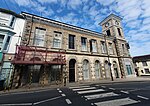Knave-Go-By
1743 establishments in EnglandMethodismUse British English from October 2017Villages in Cornwall

Knave-Go-By (also known as Knave-go-bye or Knave Go By) is a village located on the outskirts of Camborne in the English county of Cornwall in the South West region of the United Kingdom. It is in the TR14 postcode area.Knave go by is sometimes erroneously depicted as being located in Dartmoor in the neighboring county of Devon, despite no place of that name ever having existed there. The village is featured as the backdrop to the 1951 book Knave-go-by: the adventures of Jacky Nameless. It also occasionally features in books such as Collection of Weird: Place Names on account of its unusual name.
Excerpt from the Wikipedia article Knave-Go-By (License: CC BY-SA 3.0, Authors, Images).Knave-Go-By
Geographical coordinates (GPS) Address Nearby Places Show on map
Geographical coordinates (GPS)
| Latitude | Longitude |
|---|---|
| N 50.203333333333 ° | E -5.2911111111111 ° |
Address
TR14 9AE
England, United Kingdom
Open on Google Maps







